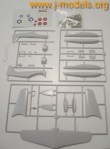
De un vistazo – Quick look
MATERIAL Y PIEZAS
MEDIA & PARTS:
- Plástico inyectado (24 piezas), resina (21 piezas) y 1 cabina vacuforme.
- Injected styrene (24 parts), resin (21 parts) and 1 vacform for the canopy.
CALCAS – DECALS:
- Finas, con buen registro y color, aunque con exceso de película transparente. Varias numerales de cola alternativos para la opción japonesa.
- Thin, with good register and colour but too much transparent film. Several tail codes for the Japanese option.
OPCIONES – OPTIONS:
- Fuerza Aérea de la Marina Imperial.
- U.S. Navy.
- Japanese Navy Air Force.
- U.S. Navy.
INSTRUCCIONES – INSTRUCTIONS:
- Hoja con resumen histórico multilingüe, plano de piezas, montaje y pintura. El ensamblaje interior tiene dibujos demasiado pequeños y no localiza con claridad la posición de algunas piezas. Código de colores de la marca Humbrol.
- A folded sheet with multilingual historical summary, parts plan, assembly and painting. Too small interior assembly pictures showing vague locations for some parts. Colours are referred to Humbrol range.
LO MEJOR – THE BEST:
- Motor e interior de resina.
- Resin engine and interior cockpit.
LO PEOR – THE WORST:
- Líneas de panel poco profundas. Piezas de plástico algo gruesas. Soportes de los flotadores simplificados.
- Shallow panel lines. A bit thick plastic parts. Simplified float struts.
VALORACIÓN – CONCLUSION:
- Maqueta irregular (excelente resina y plástico algo pobre). Aparentemente sencilla de montar, pero con posibles problemas de encaje.
- Uneven kit (outstanding resin but poor plastic parts). Apparently easy to build but you’ll probably have some fitting problems.

El Aichi E16A del fabricante checo es una maqueta que va siendo difícil de encontrar, al menos a mí me costó hacerlo. En conjunto se trata de un modelo algo desigual, pues el estupendamente detallado interior de resina no se corresponde con el resto de piezas, moldeadas en un plástico corriente aunque con detalles aceptables. El modelo viene en una única bolsa que contiene las tres bandejas de piezas, la carlinga vacuforme, piezas en resina para el motor y el interior de la carlinga y la hoja de calcas. Hay 46 piezas en total.
Aparte del encaje de las alas y el fuselaje, aparentemente esta maqueta no parece presentar mayores problemas de construcción. No hará ninguna falta añadir más detalles al interior de la cabina, pues ésta viene prácticamente con todo lo necesario. En algunas zonas de las alas presenta incluso algunos remaches que será necesario repasar, pues son tan pequeños, que desaparecerán bajo la primera capa de pintura. Las líneas de panel son en general correctas, pero poco profundas y algunas otras piezas necesitarán bastante lija (nada de acabado japonés). Por otro lado, el motor es una pequeña maravilla en resina.
Las instrucciones traen una breve referencia histórica en cuatro idiomas y presentan básicamente dos versiones de pintura: una para la versión japonesa con los colores de la Marina Imperial, y otra para la versión del Zuiun capturado por los norteamericanos al final de la guerra y, naturalmente, con insignias de las barras y estrellas. Las calcas de Propagteam son bastante finas e incluyen varios numerales para el timón de cola.
Con algo más de mejora en las piezas de plástico, esta maqueta del Zuiun podría ser un modelo muy competitivo con el de Hasegawa. Creo que esta maqueta, aparte de ser fácil de montar, podría ser un buen banco de pruebas para los que se inician con las piezas en resina.◊

The Aichi E16A of the Czech manufacturer is a kit which is becoming difficult to find, at least it was so for me. Overall this is an uneven model, with a wonderful resin interior that is not worth the rest of parts molded in quite common plastic although it shows acceptable details. The kit comes in a single plastic bag including three sprues for plastic parts, the vacformed canopy, the resin parts for the engine and the cockpit interior, and the decal sheet. There are 46 parts in all.
Apart from the fit of wings and fuselage, this kit does not apparently seem to have important difficulties to be built. Needless to say, you do not have to add more details to the interior because it comes with everything ranging from the pilot’s seat to the different instruments. In some areas of the wings the model has tiny marks for rivets which will be necessary to open or else they will disappear under the first layer of paint. The panel lines are correct in general but too shallow and some other parts will need some sanding (no Japanese finish here). On the other hand, the engine is a little resin jewel.
The instructions have a brief historical note in four languages and basically show two painting versions: one for the Japanese Navy Zuiun painted in the usual IJN colours, and another for the Zuiun captured by the U.S. forces at the end of the war with American markings. The Propagteam decals are quite thin and they include different tail codes.
With some improvement in the plastic parts this Zuiun model could become a hard competitor for Hasegawa’s version. I think this kit, apart from being easy to build, should be a good initial test for those starting to use resin parts.◊
Actualizado – Updated: 4 / 2022
Actualizado – Updated: 5 / 2017
Publicado – Published: 8 / 2006
©www.jmodels.net





Debe estar conectado para enviar un comentario.